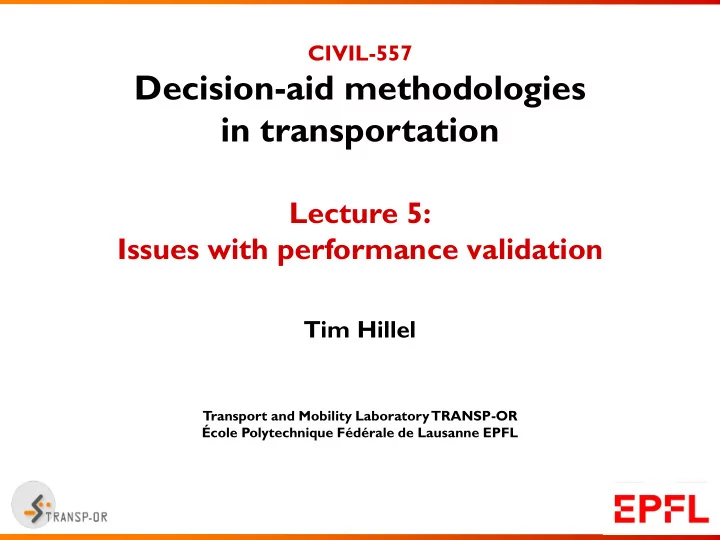

CIVIL-557 Decision-aid methodologies in transportation Lecture 5: Issues with performance validation Tim Hillel Transport and Mobility Laboratory TRANSP-OR École Polytechnique Fédérale de Lausanne EPFL
Last week Ensemble method theory – Bagging (bootstrap aggregating) and boosting – Random Forest – Gradient Boosting (XGBoost) Hyperparameter selection theory – 𝑙 -fold Cross-Validation – Grid search
Today Homework feedback/recap 1. Hierarchical data and grouped sampling 2. Advanced hyperparameter selection methods 3. Project introduction 4.
Hyperparameter selection homework Discussion of worked example
Performance estimate discrepancy Cross-validation Test Train on 4 folds, test on 1 Train on first two years, fold test on final year – Training data: 80% of – Training data: 100% of train-validate data train-validate data Random sampling Sample by year – Internal validation – External validation
Impacts of random sampling Why the discrepancy?
Dataset building process Trip details Historical Journey trip data planner service £ Cost Model
Dataset building process London Travel Demand Survey (LTDS) • Annual rolling household travel survey • Each household member fills in trip diary 3 years of data (2012/13-2014/15) • Historical ~130,000 trips trip data
Random Sampling Train T est
State of practice Systematic review: ML methodologies for mode-choice modelling 60 papers 63 studies
State of practice 56% (35 studies) use hierarchical data All use trip-wise sampling
Implications Mode choice heavily correlated for return, repeated, and shared trips. E.g.: – Return journey to/from work – Repeated journey to doctor’s appointment – Shared family trip to concert Journey can be any combination of return/repeated/shared
Implications Random sampling – return/repeated/shared trips occur across folds These trips have some correlated/identical features – E.g. trip distance, walking duration, etc ML model can recognise unique features and recall mode choice for trip in training data – data leakage
Implications Model performance estimate will be optimistically biased using random sampling for hierarchical data What about selected hyperparameters?
London dataset 74% of trips in training data (first two years) belong to pairs or sets of return/repeated/shared trips
Trip-wise sampling CV Test Diff LR 0.676 0.693 0.017 FFNN 0.680 0.696 0.017 RF 0.545 0.679 0.134 ET 0.536 0.685 0.149 GBDT 0.467 0.730 0.263 SVM 0.579 0.823 0.244
Solution - Grouped Sampling Train T est Train T est
Solution – grouped sampling Trips by one household appear purely in single fold Prevents data leakage from return/repeated/shared trips
Grouped cross-validation Train Test 𝒊 𝟐 ℎ 𝟑 ℎ 𝟒 ℎ 𝟓 ℎ 𝟔 𝒍 -folds Sample by household index into groups ℎ 𝑗
Trip-wise sampling CV Test Diff LR 0.676 0.693 0.017 FFNN 0.680 0.696 0.017 RF 0.545 0.679 0.134 ET 0.536 0.685 0.149 GBDT 0.467 0.730 0.263 SVM 0.579 0.823 0.244
Grouped sampling CV Test Diff LR 0.679 0.693 0.014 FFNN 0.679 0.688 0.009 RF 0.656 0.677 0.021 ET 0.658 0.680 0.022 GBDT 0.634 0.651 0.017 SVM 0.679 0.692 0.013
Hyperparameter selection Can we beat grid search?
Grid-search Predefine search values for each hyperparameter Search all combinations in exhaustive grid-search Simple to understand, implement, and parallelise Inefficient: – Lots of time evaluating options which are likely to be low performing – Few unique values for each hyperparameter tested
Grid search Random Search for Hyper-Parameter Optimization , Bergstra et al (2012)
Advanced hyperparameter selection Other alternatives to grid-search: – Random search – Sequential Model Based Estimation (SMBO)
Random search Define search distributions for each hyperparameter – E.g. uniform integer between 1-50 for max- depth – Can be binary, normal, lognormal, uniform, etc Simply draw randomly from distributions from each distribution
Random search Random Search for Hyper-Parameter Optimization , Bergstra et al (2012)
Random search Unique values for each iteration for each hyperparameter Even easier to parallelise than grid-search! Outperforms grid-search in practice However, still wastes time evaluating options which are likely to be low performing
SMBO As with random search, define search distributions for each hyperparameter However, base sequential draws on previous results – Lower likelihood of choosing values close to others which perform poorly – Higher likelihood of choosing values close to others which perform well
SMBO Several algorithms for sequential search – Gaussian Processes (GP) – Tree-structured Parzen Estimator (TPE) – Sequential Model-based Algorithm Configuration (SMAC) – … Several available libraries in Python – hyperopt, spearmint, PyBO
Q&A Questions from any part of the course material? Further Q&A on May 28th
Hands on Notebook 1: Advanced hyperparameter selection
Recommend
More recommend